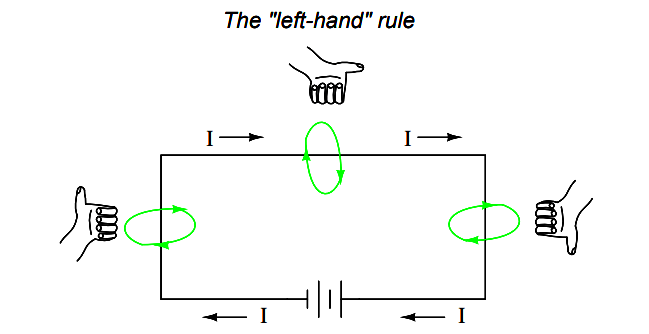The discovery of the relationship between magnetism and electricity was, like so many other scientific discoveries, stumbled upon almost by accident.
The Danish physicist Hans Christian Oersted was lecturing one day in 1820 on the possibility of electricity and magnetism being related to one another, and in the process demonstrated it conclusively by experiment in front of his whole class!
By passing an electric current through a metal wire suspended above a magnetic compass, Oersted was able to produce a definite motion of the compass needle in response to the current. What began as conjecture at the start of the class session was confirmed as fact at the end.
Needless to say, Oersted had to revise his lecture notes for future classes! His serendipitous discovery paved the way for a whole new branch of science: electromagnetics.
Detailed experiments showed that the magnetic field produced by an electric current is always oriented perpendicular to the direction of flow.
A simple method of showing this relationship is called the left-hand rule.
Simply stated, the left-hand rule says that the magnetic flux lines produced by a current-carrying wire will be oriented the same direction as the curled fingers of a person’s left hand (in the ”hitchhiking” position), with the thumb pointing in the direction of electron flow:

The magnetic field encircles this straight piece of current-carrying wire, the magnetic flux lines having no definite ”north” or ”south’ poles.
While the magnetic field surrounding a current-carrying wire is indeed interesting, it is quite weak for common amounts of current, able to deflect a compass needle and not much more.
To create a stronger magnetic field force (and consequently, more field flux) with the same amount of electric current, we can wrap the wire into a coil shape, where the circling magnetic fields around the wire will join to create a larger field with a definite magnetic (north and south) polarity:
The amount of magnetic field force generated by a coiled wire is proportional to the current through the wire multiplied by the number of ”turns” or ”wraps” of wire in the coil.
This field force is called magnetomotive force (mmf), and is very much analogous to electromotive force (E) in an electric circuit.
An electromagnet is a piece of wire intended to generate a magnetic field with the passage of electric current through it.
Though all current-carrying conductors produce magnetic fields, an electromagnet is usually constructed in such a way as to maximize the strength of the magnetic field it produces for a special purpose. Electromagnets find frequent application in research, industry, medical, and consumer products.
As an electrically-controllable magnet, electromagnets find application in a wide variety of ”electromechanical” devices: machines that effect mechanical force or motion through electrical power. Perhaps the most obvious example of such a machine is the electric motor.
Another example is the relay, an electrically-controlled switch. If a switch contact mechanism is built so that it can be actuated (opened and closed) by the application of a magnetic field, and an electromagnet coil is placed in the near vicinity to produce that requisite field, it will be possible to open and close the switch by the application of a current through the coil.
Relays can be constructed to actuate multiple switch contacts or operate them in ”reverse” (energizing the coil will open the switch contact, and unpowering the coil will allow it to spring closed again).
Initially, AC motors were constructed like DC motors. Numerous problems were encountered due to changing…
Learn about the AC Instrumentation Transducers like Potentiometer, LVDT, RVDT, Synchro, and Capacitive Transducers.
AC bridge circuit unknown impedance is balanced by a standard impedance of similar type on…
Power Quality is the general term given to represent an AC power system freedom from harmonic…
Hall effect - Voltage is proportional to current and strength of the perpendicular magnetic field.…
Learn about the Frequency and Phase Measurement from our free online electronics and electrical engineering…